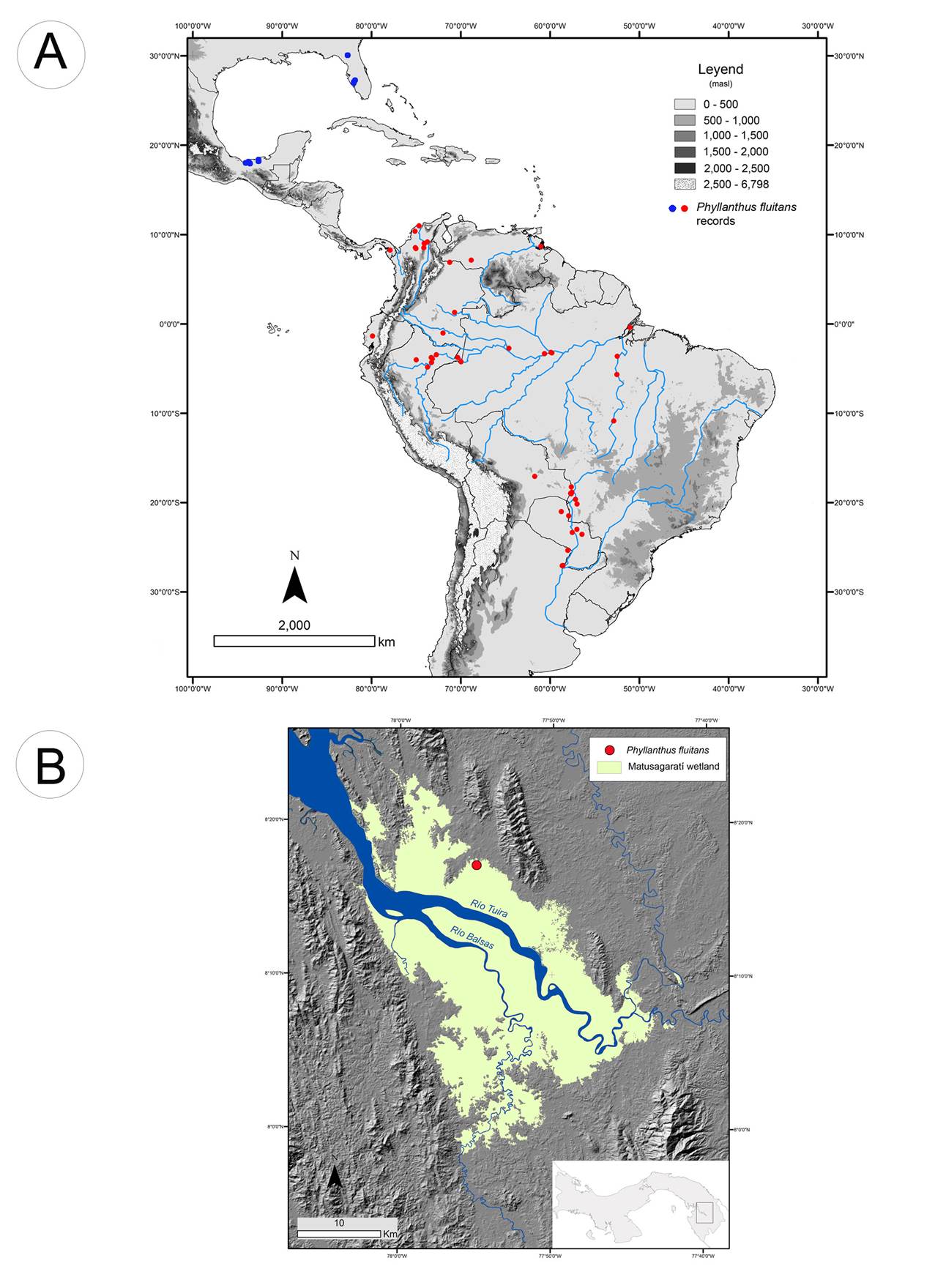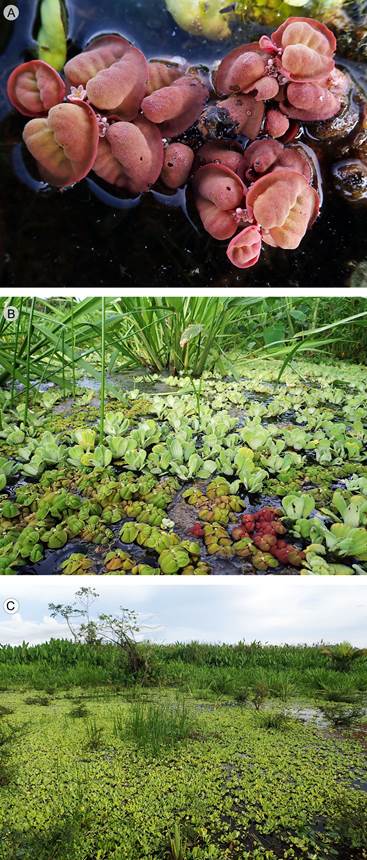Introduction
Phyllanthus L. is the largest genus in the family Phyllanthaceae with ca. 880 species in the tropics worldwide (sensu Bouman et al., 2018), and ca. 220 in the Neotropics (Webster, 2002). It shows a variety of habits, from herbs to shrubs and trees, and occurs in a wide range of ecosystems, from open habitats to the understory and canopy of wet tropical forests. Fourteen species of Phyllanthus have been reported in Panama, 10 native including one endemic to the country (the tree Phyllanthus gentryi G.L. Webster, Darién Province) and four introduced weeds or cultivated trees (Correa et al., 2004).
Three Phyllanthus species have been reported to be aquatic. Two African herbs, Phyllanthus felicis J.F. Brunel and Phyllanthus leonardianus Lisowski, Malaisse & Symoens are rooted emergent plants, while the neotropical Phyllanthus fluitans Benth. ex Müll. Arg. is a free-floating species, the only one within the entire family (Lisowski et al., 1974; Brunel, 1987).
Phyllanthus fluitans is included in the subgenus Phyllanthus within the monotypic section Salviniopsis Holm-Nielsen ex Jean F. Brunel, thus containing this species only (Brunel, 1987; Falcón Hidalgo et al., 2020). It is a small floating species similar in habit and leaf shape to the water fern Salvinia Ség. and is usually described as Salvinia-like. It has a highly specialized morphology with leaves modified as floating organs, in the form of aerial sacs (Lot et al., 1980).
Phyllanthus fluitans was discovered and first collected by Richard Spruce in the lower Amazon of Brazil in 1850. The specimen was sent to George Bentham and its original description published in 1863 by Jean Müller (Müller Argoviensis, 1863; Lot et al., 1980). It has since been reported in Paraguay (Chodat, 1906), Colombia (Schultes, 1949), Peru (Macbride, 1951; Gómez, 2006), Argentina (Lourteig, 1955; Donnet and Yedro, 1996), Ecuador (Holm-Nielsen, 1980), Venezuela (Díaz and Rosales, 2006), Bolivia (Jørgensen et al., 2014) and Mexico, where it was doubted whether it is native (Lot et al., 1980; Webster, 2002), and recently Espinosa-García and Villaseñor (2017) considered it a non-native species.
Due to its attractive leaf shape and coloration, the species is widely used in aquariums worldwide. In Florida it has escaped cultivation and now poses a serious threat to natural ecosystems as an invasive species (Wilder and Sowinski, 2010; PPQ, 2017).
The objective of this study is to report the presence of Phyllanthus fluitans in Panama, more specifically in the Matusagaratí complex of wetlands, in the Darién Province.
Materials and Methods
The Tuira and Balsas rivers in Darién, Panama, are the backbone of the Matusagaratí complex of wetlands, one of the largest wetlands in Central America, covering around 50,000 ha (Carol et al., submitted). It includes river margins and adjacent floodplains, which contain different vegetation types such as swamp forests, scrublands and herbaceous formations. All these communities are periodically flooded, and their structure and species composition are defined by their landscape position and the nature and duration of the inundation, which can be from estuarine waters related to daily tides, spring tides, fluvial and/or rainfall flooding (Grauel, 2004; CREHO, 2015; MiAmbiente, 2016; Carol et al., submitted). Away from the main rivers’ influence, extensive areas are covered in herbaceous formations dominated by Typha dominguensis Pers. and other wetland species (Ibáñez et al., in prep.). Precipitation in the region has been reported to be around 2500 mm/year, with a pronounced dry season from January to April, and a wet season from May to December. Mean temperature varies from 21.6 °C to 24 °C ((Grauel, 2004; MiAmbiente, 2016). Wetland soils in the study area are gleyed, acidic (4.5-5 pH), and saturated, with the water table just below the surface in anoxic conditions (Ibáñez et al., in prep.).
As part of a research project that aims at describing the hydrology, vegetation and avifauna of the complex of wetlands of Matusagaratí, a floristic survey was carried out. General collecting of aquatic flora in selected sites was done during four trips (a total of 21 days in the field) encompassing both the dry and wet seasons. All specimens were preserved in newspaper with 50% ethanol while in the field and dried in the herbarium afterwards. Botanical specimens collected were studied at the University of Panama herbarium (PMA), where voucher specimens of all collections have been deposited. The results of the general floristic survey will be published in a forthcoming paper (Ibáñez et al., in prep.).
Phyllanthus fluitans is the only aquatic free-floating species in the genus Phyllanthus and has unique morphological characters that make it unmistakable, such as the aerial sacs of the leaves. The specimen collected, A. Ibáñez and N. Gálvez 9672 AI, was studied in detail and compared with the images of type specimens in the JSTOR Global Plants database (JSTOR, 2020) and with available online resources, such as the numerous images of the species (e.g. UF/IFAS, 2020). Our specimen fits published descriptions of the species such as those of Lot et al. (1980) and Holm-Nielsen (1980). In order to complement the distribution data of P. fluitans, we consulted the GBIF database (GBIF, 2020) and used that information to draw the map in Fig. 1A. Maps were made with ArcMap version 10.5 (ESRI, 2016). The IUCN Red List Categories and Criteria (IUCN, 2001) and GeoCAT (Bachman et al., 2011) are used to determine the conservation status of this species in Panama.

Figure 1: A. distribution of Phyllanthus fluitans Benth. ex Müll. Arg. Occurrence data from GBIF (2020); in red native, in blue non-native records; B. location in Matusagaratí complex of wetlands in Darién Province, Panama.
Results
Phyllanthus fluitans Benth. ex Müll. Arg., Linnaea 32(1): 36. 1863. Figs. 2A-B.

Figure 2: A. flowering Phyllanthus fluitans Benth. ex Müll. Arg.; B. green and red plants of P. fluitans growing with Pistia stratiotes L.; C. seasonal pool with wetland vegetation where P. fluitans was found. Photos by Alicia Ibáñez.
TYPE: BRAZIL. Pará, Brasilia, prope Santarem ad Rio Negro in aquis fluitans cum Azollis, R. Spruce s.n. (lectotype not designated, putative syntypes: A!, BM!, G!, G-DC!, GH!, K!, MPU!, NY!, P!, RB!, TCD!).
Macrophyte herb with horizontal stems, 3-5 cm long; branching non-phyllanthoid; rootlets many; stipules acuminate, 2 mm long; leaves sessile or with up to 1 mm long petiole, distichous, blades orbicular, cordate at base, 12-20 mm broad, glandular, with the two sides inflated and forming 2 aerial sacs, margin entire, revolute in immature leaves, leaves green, sometimes red; plant monoecious; inflorescences axillary cymules, flowers 2-4, unisexual, apetalous, petaloid sepal lobes 6, white or light pink; male flowers, disc with 6 segments, stamens 3, filaments free, anthers horizontally dehiscent; female flowers, disc with 6 lobules, superior ovary with 3 locules, 2 ovules each, styles 3, bifid, stigmas dark, papillose; fruits capsular depressed-globular, 3 mm wide, seeds triangular, 6 per capsule, dispersed by water. For a detailed morphological and anatomical description see Holm-Nielsen (1980) and Lot et al. (1980).
Material examined: PANAMA. Provincia de Darién, Humedal Laguna de Matusagaratí, El Golfo, 18 m s.n.m., 8°17'20.45''N, 77°54'50.88''W, 6.X.2019, fl., A. Ibáñez and N. Gálvez 9672 AI (PMA).
Habitat and ecology: Phyllanthus fluitans was found in a seasonal pool in the NW corner of the herbaceous wetland (Fig. 1B). It was growing abundantly during the rainy season in October and November 2019 (Figs. 2A-C). The pool was ca. 80 cm deep and accompanying free floating and rooted macrophyte species were Pistia stratiotes L., Ceratopteris thalictroides (L.) Brongn., Spirodela polyrhiza (L.) Schleid., Azolla filiculoides Lam., Eleocharis spp., Thalia geniculata L., Typha dominguensis, Crinum erubescens Aiton, Nymphoides indica (L.) Kuntze, Nymphaea sp., Ludwigia nervosa (Poir.) H. Hara, Ludwigia spp. and Aeschynomene cf. indica L. This part of the herbaceous wetland had no standing water during the dry season of 2019, although the soil was damp enough for some of the floating species to remain alive. The whole region burned at the end of the same season, in early May 2019. This area is bordered by cattle pastures and the animals are free to enter during the dry months, where they usually rest and refresh.
Conservation status: only one population of P. fluitans was found in the Matusagaratí wetland. This region is included in the Filo del Tallo-Canglón Forest Reserve, a protected area within the National System of Protected Areas of Panama (MiAmbiente, 2016). Despite its protected status, the herbaceous vegetation is frequently burned and used by cattle ranchers, practices that are causing a highly negative impact on the flora and fauna of the wetland. Moreover, large tracts have been recently drained and transformed to intensive rice and oil palm plantations (CREHO, 2015). According to our national conservation analysis, P. fluitans should be considered as Endangered (EN B2ab (ii, iii, iv)) in Panama, because of its restricted Area of Occupancy (4 km2) and the threats the whole region faces, especially the uncontrolled burning of pastures and adjacent herbaceous wetlands.
Discussion
Phyllanthus fluitans is a South American species that grows mostly along the Amazon river and tributaries but it has also been reported in the Magdalena, Orinoco and Paraná watersheds (GBIF, 2020). It is notable that the Ecuadorean record is west of the Andes (Holm-Nielsen, 1980) (Fig. 1A).
In Mexico, the species occurs in the Tabasco wetlands, in permanent pools of temporarily flooded cattle pastures (Lot et al., 1980). This disjunct distribution pattern has been the subject of some discussion. Despite the similarity of wetland habitats with South America and the many shared widespread species, the absence of P. fluitans in Central America and its occurrence in a secondary habitat such as flooded cattle pastures suggest that it is a recently introduced species ((Lot et al., 1980; Webster, 2002; Espinosa-García and Villaseñor, 2017), and might be explained by long distance dispersal by migratory birds (Green et al., 2002; Mora-Olivo et al., 2013).
Although the presence of P. fluitans in Panama could also be explained as a recent introduction by migrant waterfowl, it is likely an extension of its native South American range. The herbaceous flora of these wetlands had never been surveyed before, and as in the case of other wetland species (e.g. Montrichardia linifera (Arruda) Schott, Ortiz et al.,2020), this region has a strong affinity to South America.
In Panama, the species is not for sale in aquariums (MiAmbiente, 2020), so the possibility of it escaping cultivation is not considered here. This is also supported by the fact that the area where it was found is remote, with difficult access by dirt roads, very far from putative sources of this kind of invasive species (aquarium plants).
The habitat and ecological characteristics of the P. fluitans population from Darién are consistent with documented specimens from South America and Mexico (Lot et al., 1980; Schmidt-Mumm and Janauer, 2014). The distribution of aquatic plants fluctuates throughout the year. With rising water level, the floating vegetation develops and expands until it reaches its full extension during the high-water period (Junk, 1970). Phyllanthus fluitans has only been observed during the high-water period of the rainy season in October-November 2019, growing amid exuberant floating vegetation. In Mexico it has been reported to behave as an annual or perennial herb according to the environmental conditions and duration of the inundation ((Lot et al., 1980), and the species has also been reported as being able to root and grow in damp soil (Sowinski, 2011). In the Matusagaratí wetland, the species seems to be able to survive the strong dry season of 4-5 months, either as seeds or rooted in the damp soil.
This new record of P. fluitans in Darién, Panama, represents an extension of the known natural range of the species. More intense fieldwork is needed to evaluate the range and ecology of this species in Darién and Panama and formulate more robust hypotheses to explain its presence in the region. The only population found is highly vulnerable and it should be considered a conservation target. This study reaffirms the importance of continuing with botanical explorations in botanically poorly known regions, such as the Darién.











 nova página do texto(beta)
nova página do texto(beta)



